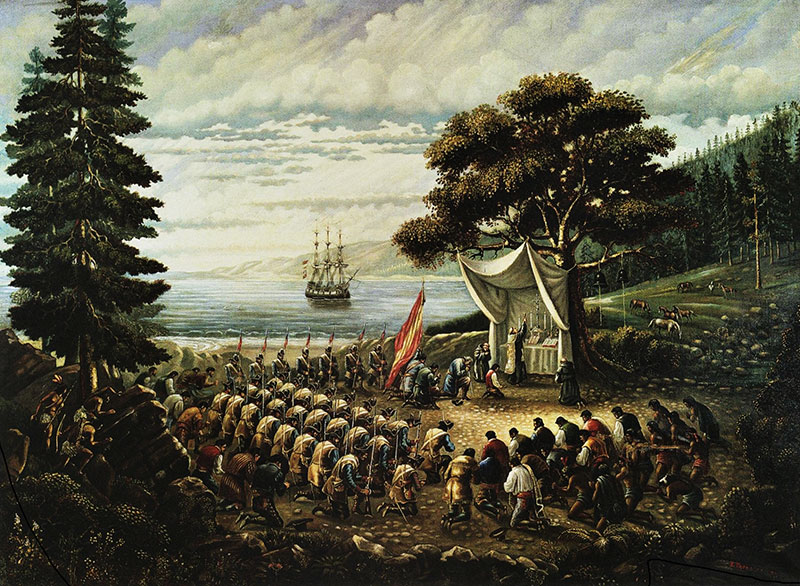
Elizabeth Bruenig’s New York Times op-ed “A Saint’s Sins” was a lengthy indictment of the character and actions of Saint Junipero Serra. It is tempting to refer to it as a masterpiece of character assassination, except that it is not masterful. It recycles modernist and old anti-Catholic attacks that ignore the historical record and promote a modern narrative of oppression, torture and enslavement of the Indians. She places Saint Junipero among those who participated in the oppression in his efforts to convert the Indian tribes.
By referring to the saint’s “sins,” the author seeks to change the Church’s definition of a saint to fit modern narratives. This attempt runs contrary to the Church teaching that states a saint is someone who practiced heroic sanctity proven by a life that is carefully scrutinized. The Church makes sure the actions, piety and orthodoxy of any future saints are flawless and worth of imitation. The process of canonization used to be extremely rigorous. If any of the charges and “sins” alleged by Mrs. Bruenig were true, he would not be a saint.
The Enviable Record of the California Mission System
Indeed, the contrary was true. Saint Junipero Serra was a selfless and dedicated priest who led a group of Franciscan missionaries into California in 1769, where he remained until his death of tuberculosis in 1784. Even though he was in poor health, he established nine missions. His successors increased that number until there were twenty-one missions in all, stretching out over five hundred miles of the California coast.
The mission system had two goals. First and foremost, they sought to bring the Catholic faith to the native Californians. At the same time, these Franciscans were practical men. The full practice of Catholicism requires both education and access to the sacraments. To grow in their new-found faith, the natives settled near the missions. That necessity led to the second goal, to teach the natives agricultural skills so that they could abandon the miserable nomadic life from which they suffered from disease, hunger, superstition and wars with other tribes.
The missions were phenomenally successful, both in spiritual and temporal terms. Tens of thousands of California Indians embraced Christianity, received the sacraments and lived lives of Christian virtue. Catholicism remained strong among their descendants for generations. They also enjoyed economic prosperity. The Catholic Encyclopedia presents evidence of that bounty. “The official records show that in the twenty-one missions of Upper California from the year 1770 to the end of 1831, when the general reports cease, there were harvested in round numbers 2,200,000 bushels of wheat, 600,000 bushels of barley, 850,000 bushels of corn, 160,000 bushels of beans, and 100,000 bushels of peas and lentils, not to mention garden vegetables, grapes, olives, and various fruits, for which no reports were required.”
The missionaries introduced apples, oranges, peaches, pears, plums, prunes, lemons, grapes, pomegranates, olives and nuts. They constructed irrigation systems. At the height of their prosperity, the missions owned 232,000 head of cattle, 268,000 sheep and 34,000 horses. This immense wealth benefited the Indians, not the Franciscans, who practiced evangelical poverty.
The Evidence of Historians
The Bruenig narrative does not acknowledge the immense material improvements to the lives of countless Indians. Postmodern historians have taken a success story and turned into a cultural calamity. They claim the bountiful harvests were the weapons by which the Spanish oppressors turned the natives from hunter-gatherers to successful farmers.
Far from helping the Indians, they claim the Spanish imported animals that ate all the wild plants and drove away wild game. Hunger, not God’s grace, drove the Native Americans to enter the missions, become Christians, and adopt an agricultural life. Once in the mission, they claimed the oppressed natives were forced to stay. How a few thousand Spaniards managed to destroy millions of acres of desert and wilderness is not entirely explained nor how a few friars with five or six soldiers manage to keep a few thousand Indians captive inside the mission compound.
The Myth of Oppression
Citing historians at today’s universities, the left has pieced together a picture of the mission as the cruel sites of the torture, enslavement and murder of native Indians. Saint Junipero comes out as a well-intentioned but willful participant in a colonization system he could not control. Ever hostile to Christianity, such scholars tend to present an account as they imagine it to be than what it was.
The historical accounts of eyewitnesses and later observers report a contrary record of what happened at the missions. The Franciscans knew that they could only evangelize if they treated the Indians with extreme kindness, mercy and understanding. They explained the Christian Faith in its simplest form in the many Indian languages in which they became expert speakers.
The friars drew up rules to keep order in the missions according to the customs of the time and enforced by Indian chiefs and leaders. These rules have been the source of constant calumny against the Franciscans, who defended the Indians from injustice and abuse. The Catholic Encyclopedia reports that “The stories of cruelty prevalent among closet historians were either manufactured or exaggerated out of all resemblance to the truth by the enemies of the friars, because the latter stood between white cupidity and Indian helplessness.”

Each mission was organized like a great family with as many as two or three thousand natives. Morning and evening prayers were held in common at the church. Everyone attended daily Mass, and the Indians enthusiastically provided the singing for High Masses and other occasions. The evening was the time of amusements consisting of music and games.
The Catholic Encyclopedia reports that the “neophyte community was like one great family, at the head of which stood the padre, under which title the missionary was universally known. To him, the Indians looked for everything concerning their bodies as well as their souls. He was their guide and protector.”
The Testimony of Scholars
The peace that prevailed in the missions was such that Protestant historian, Alexander Forbes, who was in California at the time, was impressed. He declared that the Indians showed unbounded affection and emotion to the missionaries whom they saw not only as fathers and friends but also as figures to be treated with great reverence.
The Protestant journalist, historian Charles Fletcher Lummis, came to California in 1884, when the mission system was still a living memory. He described the mission system as “the most just, humane, and equitable system ever devised for the treatment of an aboriginal people.”
To cite a modern living author, Dr. Iris Engstrand, who taught history at the University of San Diego, reports that Saint Junipero was “not a person who was enslaving Indians, or beating them, ever…. Even after the burning of the mission in San Diego [November 5, 1775], he did not want those Indians punished. He wanted to be sure that they were treated fairly.”
Such accounts and testimonies hardly reflect the oppressive narrative related by Mrs. Bruenig and her postmodern scholars. Perhaps a more fitting story of oppression that needs to be told is that of the secular anti-Catholic Mexican government that destroyed the mission system and caused the suffering of countless Catholic Indians.
A Straw Man
The campaign against Saint Junipero is now using false accounts and postmodern scholars to justify the vandalizing of Churches, and pulling down of his statues.
Logicians call such attacks “straw man arguments.” The dissenters construct an image that never existed. They vest it with just enough information to attract the attention of their ill-informed partisans. Then they burn the effigy, presuming to purge reality.
The real story of Saint Junipero does not lend itself to such an attack. Thus, “woke” historians insert his life and deeds inside a colonial narrative that can be distorted to destroy his reputation. They seek to turn the saint into a sinner.
Informed people can defeat straw man arguments by providing facts that disprove these false narratives. Catholics need to stand up to oppose the slandering of Saint Junipero Serra and the magnificent missionary work of the Holy Catholic Church.

